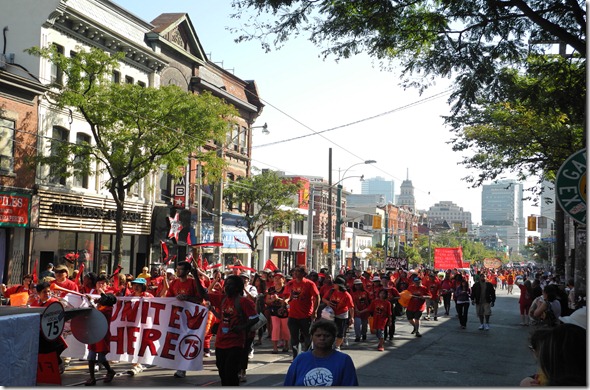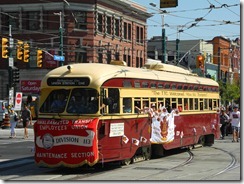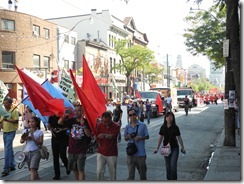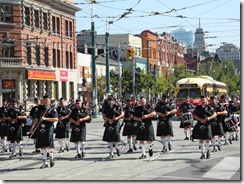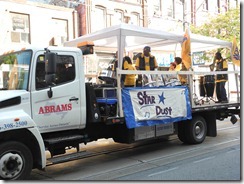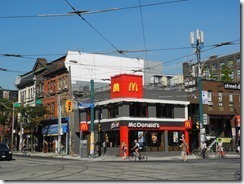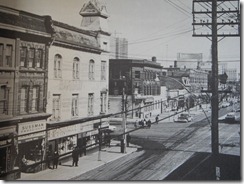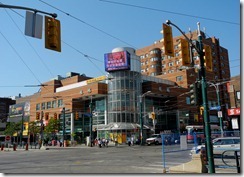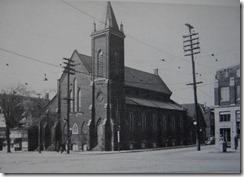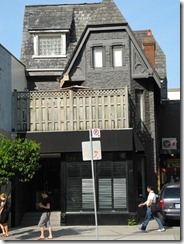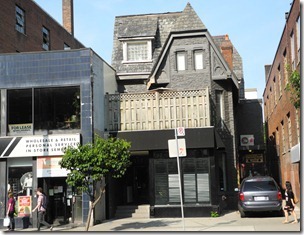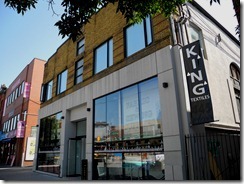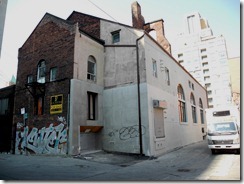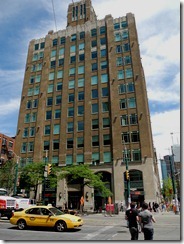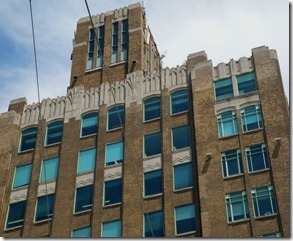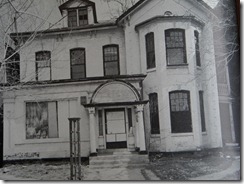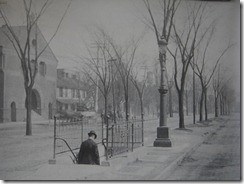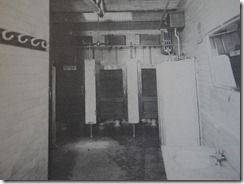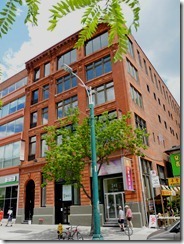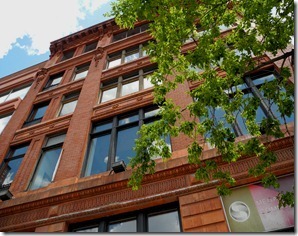The 2012 Labour Day Parade passing along Queen St. West. The view is looking east toward Spadina Avenue.
Viewing the Labour Day on Queen Street West on 3 September 2012, I wondered about the origins of the day. For most Canadians, it is simply the last holiday weekend of the summer – a time to close up the cottage, enjoy a backyard barbeque, or simply “goof-off” with friends or family. Few realize that the holiday has its origins in Toronto, eventually becoming a Canadian holiday that was copied by the Americans.
On 15 April 1872, a large demonstration was held in Toronto to help those who received starvation wages with little or no benefits. In that era, labour unions were forbidden by law. The parade was an enormous success and it drew attention to the plight of those working in factories and sweat shops across the country. A few months later, a similar demonstration was held in Ottawa, and it marched past the Parliament Buildings. Later in the day, Sir John A. Macdonald promised to repeal the legislation against trade unions and the law was passed the same year.
Although the first Labour Day was held in the spring (April), the following year it was moved to September. It is difficult to believe today that we owe a Conservative Government thanks for protecting the wages of workers. How far the present-day Conservatives have strayed. Breaking the unions is a now priority in Ottawa. The attempt is to lower wages, which is a race to the bottom that benefits only those at the very top.
In the nineteenth century, the American were slow to catch-up with the trend to proclaim a Labour Day. The first state in the union to declare it a holiday was Oregon, in 1894.
Canadians appear to have forgotten the enormous contribution that trade unionism has given to the quality of life across the nation. Many harbour ill feelings because unions have sometimes abused their powers and at times made bad decisions. This is true for all organizations, even churches, and no individual can honestly claim that they have always made wise choices. On the whole, unions have improved wages and benefits for many Canadians. The problem is that those who are not unionized have not done as well.
Today, some governments and many large corporations oppose unions as they wish to boost profits. They attempt to divide the populace by asking non-unionized workers why those who are unionized should have better salaries and perks than they have. It is so easy to buy into this argument and demand a reduction in wages and benefits of those who have fared well. In the end, this will result in lower earnings for everyone.
Perhaps Labour Day is a good time to consider these matters, although on a sun-filled day in September, I admit that it is difficult to engage in such perplexing thoughts.
Happy Labour Day Canada.
Photos of the Labour day Parade on Queen Street West, near Spadina Avenue on 3 September 2012
For other posts about Toronto’s history and happenings throughout the city, follow the links:
The importance of the northwest corner of Queen and Spadina, where a McDonald’s is located.
https://tayloronhistory.com/2012/08/27/mcdonalds-at-queen-and-spadina-on-an-historic-site/
The history of the site of the Dragon City Mall on the southwest corner of Spadina and Dundas Streets.
https://tayloronhistory.com/2012/08/25/torontos-heritage-the-southwest-corner-of-queen-and-spadina/
The historic home on Spadina, now occupied by Paul Magder Furs
The 1890s church of St. Margaret’s Anglican on Spadina south of Queen street. The church is now hidden from view by a modern addition across the front of it.
https://tayloronhistory.com/2012/07/25/vanished-church-on-torontos-spadina-ave-is-rediscovered/
The iconic Balfour Building at Spadina and Adelaide Streets
House on Spadina south of Dundas Street – today it is difficult to believe that it was once a prestigious residential building
https://tayloronhistory.com/2012/07/04/torontos-architectural-gems-is-this-one-a-joke/
The vanished underground men’s washroom from the early nineteenth century, located in the middle of the street at Queen and Spadina.
The site of the Consumers’ Glass Building at 239-241 Spadina, south of Dundas Street. It is presently under restoration.
To view the Home Page for this blog: https://tayloronhistory.com/
